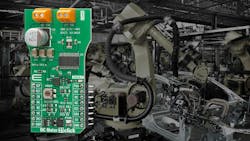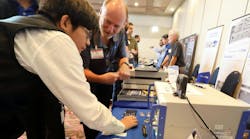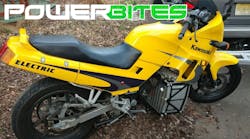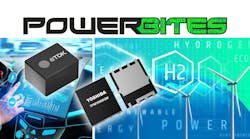Flexible Smart Driver Board for Brushed DC Motors Delivers Precision Control
What you'll learn:
- Features of MIKROE's DC Motor 31 Click board.
- Applications for the new Click board.
- The H-bridge driver that the board is based on.
The DC Motor 31 Click is a compact add-on board designed to drive brushed DC motors, providing precise control, torque adjustment, and fault monitoring for a wide range of applications. This recent addition to MIKROE’s series of standards-based Click board hardware/software platforms can dramatically cut development time of industrial automation, consumer devices, and robotic systems that require robust and energy-efficient brushed DC motor control.
DC Motor 31 Click is based on the TB67H482FNG, a bipolar-CMOS-DMOS (BiCD) constant-current single H-bridge driver IC from Toshiba Semiconductor. Supporting motor supply voltages from 8.2 to 44 V and output currents up to 4 A, it integrates PWM constant-current drive, decay mode selection, and a trimmer for fine motor-speed tuning.
In common with all Click boards released by MIKROE, DC Motor 31 Clicks also feature the ClickID function that enables automatic identification by the host system to simplify usage. Devices are fully compatible with the mikroBUS socket and can be employed on any host system supporting the mikroBUS standard. They come with the mikroSDK open-source libraries, offering excellent flexibility for evaluation and customization.
MIKROE and its user community have already created hundreds of ready-to-use embedded projects featuring the DC Motor 31, which can be accessed at the company’s EmbeddedWiki.
Next in This Edition of PowerBites
More PowerBites
About the Author
Lee Goldberg
Contributing Editor
Lee Goldberg is a self-identified “Recovering Engineer,” Maker/Hacker, Green-Tech Maven, Aviator, Gadfly, and Geek Dad. He spent the first 18 years of his career helping design microprocessors, embedded systems, renewable energy applications, and the occasional interplanetary spacecraft. After trading his ‘scope and soldering iron for a keyboard and a second career as a tech journalist, he’s spent the next two decades at several print and online engineering publications.
Lee’s current focus is power electronics, especially the technologies involved with energy efficiency, energy management, and renewable energy. This dovetails with his coverage of sustainable technologies and various environmental and social issues within the engineering community that he began in 1996. Lee also covers 3D printers, open-source hardware, and other Maker/Hacker technologies.
Lee holds a BSEE in Electrical Engineering from Thomas Edison College, and participated in a colloquium on technology, society, and the environment at Goddard College’s Institute for Social Ecology. His book, “Green Electronics/Green Bottom Line - A Commonsense Guide To Environmentally Responsible Engineering and Management,” was published by Newnes Press.
Lee, his wife Catherine, and his daughter Anwyn currently reside in the outskirts of Princeton N.J., where they masquerade as a typical suburban family.
Lee also writes the regular PowerBites series.





